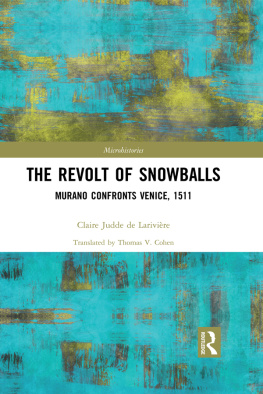The Revolt of Snowballs
The Revolt of Snowballs unpicks a rare and turbulent protest and investigates the meaning behind it. On 27 January, 1511, the island of Murano was the scene of an exceptional collective action, when the representative of Venice, exercising power in the island on behalf of the Serenissima, was hunted by the inhabitants under a shower of snowballs and to the sound of hostile clamour. This book uses microhistory techniques to examine the trial records of the incident and explores the lives of Muranos inhabitants at its heart.
The book begins by providing a detailed introduction to life in Murano during the sixteenth century, including its political framework and the relationship it shared with Venice. Against this context, the political skills of Muranos inhabitants are considered and key questions regarding political action are posed, including why and how people chose to protest, what sense of justice drove their actions, and what form those actions took. The latter half of the book charts the events that followed the revolt of snowballs, including the inquest and its impact on Muranos society.
By putting Murano under the microscope, The Revolt of Snowballs provides a window into the cultural and political world of early modern Italy, and is essential reading for historians of revolt and microhistory more broadly.
Claire Judde de Larivire is Senior Lecturer at the University of Toulouse and Honorary Research Fellow at Birkbeck, University of London, UK. Her previous works include Naviguer, commercer, gouverner. conomie maritime et pouvoirs Venise (XVe-XVIe sicles), 2008; Le peuple est la cit. Lide de popolo et la condition des popolani Venise (XVe-XVIe sicle), Annales HSS, 2013, n4 (with Rosa M. Salzberg); and The Urban Culture of the Ordinary People. Space and Identity in Renaissance Venice (Fifteenth-Sixteenth Centuries), Medieval Urban Culture, ed. by Andrew Brown and Jan Dumolyn, Turnhout, 2017.
Microhistories
Series editors: Sigurur Gylfi Magnsson and Istvn M. Szijrt
The Microhistories series is open to books employing different microhistorical approaches, including global microhistories aimed at grasping world-wide connections in local research, social history trying to find determining historical structures through a micro-analysis, and cultural history in the form of microhistories that relate directly to large or small scale historical contexts. They are interesting stories that bring the everyday life and culture of common people of the past close to the readers, without the aspiration of finding answers to general big questions or relating them to the grand narratives of history. The series is open to publishing both theoretical and empirical works but with a focus on empirical monographs, which can communicate stories from the past and capture the imagination of our readers.
Published:
The Revolt of Snowballs
Murano confronts Venice, 1511
Claire Judde de Larivire
Forthcoming:
A Tale of a Fool?
A Microhistorical Study of an 18th-Century Peasant Woman
Gun Hallgrmsdttir
Roman Tales
A Readers Guide to the Art of Microhistory
Thomas V. Cohen
Who Killed Panayot?
Reforming Ottoman Legal Culture in the 19th Century
Omri Paz
First published 2018
by Routledge
2 Park Square, Milton Park, Abingdon, Oxon OX14 4RN
and by Routledge
711 Third Avenue, New York, NY 10017
Routledge is an imprint of the Taylor & Francis Group, an informa business
2018 Claire Judde de Larivire
Translated by Thomas V. Cohen
The right of Claire Judde de Larivire to be identified as author of this work has been asserted by her in accordance with sections 77 and 78 of the Copyright, Designs and Patents Act 1988.
All rights reserved. No part of this book may be reprinted or reproduced or utilised in any form or by any electronic, mechanical, or other means, now known or hereafter invented, including photocopying and recording, or in any information storage or retrieval system, without permission in writing from the publishers.
Trademark notice: Product or corporate names may be trademarks or registered trademarks, and are used only for identification and explanation without intent to infringe.
British Library Cataloguing in Publication Data
A catalogue record for this book is available from the British Library
Library of Congress Cataloging in Publication Data
A catalog record for this book has been requested
ISBN: 978-1-138-06606-9 (hbk)
ISBN: 978-0-429-50433-4 (ebk)
Let me say here a few words, to lay out the scholarly and editorial project that shaped the writing of the original La rvolte des boules de neige , which came out in 2014 with the Paris publishing house, Fayard. The form and content of my book owe a great deal to an intellectual project and editorial mission proper to its land of origin. In France, publishers have fostered a substantial body of writing that, all the while it looks to serious research, reaches out to a broader public. I wanted to join that undertaking by furnishing a piece of original research on a little-explored topic, while making it accessible to general readers who care for history.
That meant that I had to keep several complementary goals in mind. On the one hand, the inquiry into the Revolt of the Snowballs allowed me to analyse the forms of everyday politicization, and the way non-nobles contributed, in so many ways, to the political construction of their communities. So, I could use a rather dramatic event to show the importance of everyday political practices for communities institutional and political organization. On the other hand, I wanted to bring to the fore Muranos social density and lay out the nature of the places popolo , as the island is an exceptionally well-documented place for an historical study of ordinary people. It was a world at once big enough to support a great variety of social interactions, and yet small enough to allow a scholar to identify the actors and, sometimes, to trace their life stories. These two conditions variety of actions and precision of the record are essential if one wants to study the popolo well, without falling back on threadbare generalizations that stunt analysis.
These two objectives required of me an authorial stance that took very seriously the persons whose history I hoped to write. I had no wish to compile an erudite, compendious monograph about Murano. Given the variety and abundance of the documents I collected, I could indeed have done so. But I chose instead to use this surprising tale of the Revolt of the Snowballs as a device to tell a story that embodies the histories of both individuals and collective groups. So my process of writing could in no way be sundered from research I had done. It fell to me to make my choices, boil matters down to essentials, bring good details to the fore and, step by step, trace the histories both of the trial and of the islands inhabitants. That editorial choice persuaded me to keep my footnotes simple, mostly just archival references, while I placed my historiographical comments and bibliography at the end of the work, organized by theme. Despite the light touch, nothing written in this book is made up or imagined. Rather, every contextual remark, anecdote or action comes straight from the archival papers.
The Revolt of Snowballs is thus the fruit of complementary desires and goals, at once methodological, analytic, and stylistic. In its form, rhythm, and deliberately modest bulk, it reflects the scientific and methodological preoccupations that marked its drafting and production.









![Bosworth - Italian Venice: a history[Electronic book]](/uploads/posts/book/194557/thumbs/bosworth-italian-venice-a-history-electronic.jpg)

